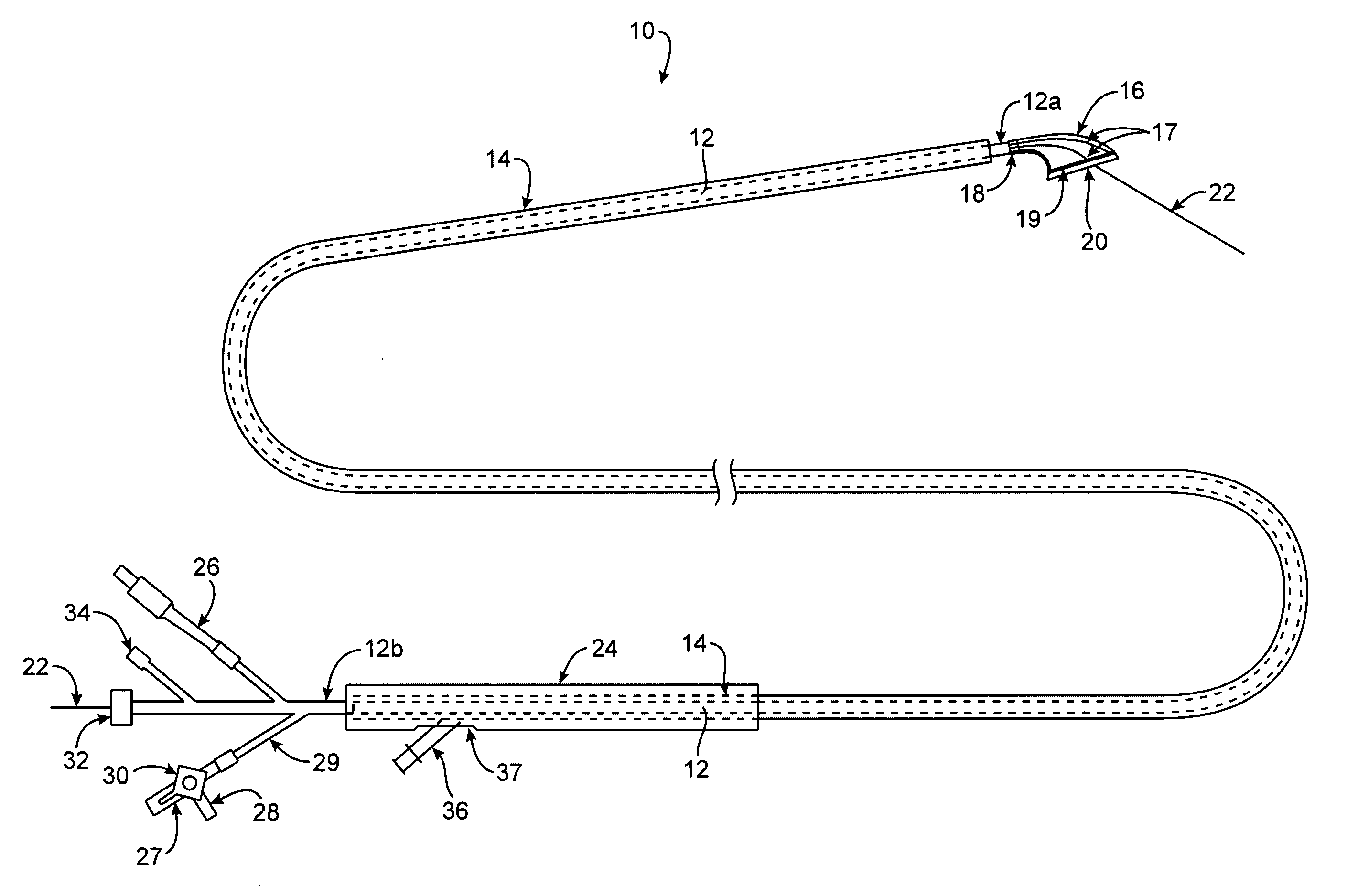[0016] In some embodiments, the apparatus also includes a sheath disposed over at least part of the catheter body and having a proximal end and a distal end. In such embodiments, the energy transmission member and the housing are collapsible and axially movable relative to the sheath, from a collapsed position within the sheath to an expanded position beyond the distal end of the sheath. Optionally, the sheath may include a bend, closer to its distal end than its proximal end. In some embodiments, the catheter body also includes a bend, closer to its distal end than a proximal end of the sheath. In such embodiments, the catheter body bend and the sheath bend allow a user to change an angle of orientation of the energy transmission member and the housing by moving the
Catheter body relative to the sheath. Optionally, the sheath may also include a stretchable distal end for facilitating movement of the housing and the energy transmission member from the expanded configuration to the collapsed configuration within the sheath.
[0022] In some embodiments, the
catheter device further includes an
irrigation tube extending through the catheter body and having a distal aperture disposed within the housing and a
vacuum tube extending through the catheter body and having a distal aperture disposed within the housing. In one embodiment, an inner surface of the housing includes a plurality of ridges and valleys forming channels to direct
irrigation fluid from the
irrigation tube distal aperture toward the tissues and subsequently toward the
vacuum tube distal aperture. The inner surface may optionally further include an irrigation fluid blocking surface feature to help direct fluid forward and away from the irrigation tube distal aperture. In some embodiments, the irrigation tube is adapted to allow passage of a guidewire therethrough.
[0024] In some embodiments, the planar
surface electrode includes an outer rim extending at least partially around an outer circumference of the
electrode and a plurality of metallic struts formed in a pattern within the outer rim. In one embodiment, the rim is discontinuous, thus enhancing collapsibility of the
electrode. In other embodiments, the rim includes one or more inward bends directed toward the struts, the inward bends adapted to promote collapsibility of the
electrode. In some embodiments, some of the struts are attached to other struts as well as to the outer rim. In other embodiments, the struts are attached only to the outer rim and not to one another. In other embodiments, the struts are not attached at all to the outer rim, and may be attached to the housing through the material of the housing or other structure. The pattern of struts may include at least one area of more closely positioned struts relative to another area of less closely positioned struts, such that different areas of the electrode provide different amounts of energy transmission to the tissues. Alternatively or additionally, the pattern of struts may include at least one area of thicker struts relative to another area of thinner struts, such that different areas of the electrode provide different amounts of energy transmission to the tissues.
[0025] In some embodiments, the pattern of struts includes at least one fold line along which the electrode folds to allow the electrode to collapse. In some embodiments, the struts are attached asymmetrically to the outer rim such that a first half of the housing and electrode folds into a second half of the housing and electrode when the housing and electrode assume their collapsed configurations. For example, in some embodiments, the struts are attached to the outer rim at between 8 and 16 attachment points to enhance collapsibility of the electrode.
[0027] In various embodiments, an electrode may include any of a number of additional features. For example, in some embodiments, the electrode further comprises at least one guidewire aperture to allow passage of a guidewire through the electrode. The guidewire aperture may be disposed along the electrode in an offset position to facilitate positioning of the electrode over the anatomic defect. Some embodiments include two offset guidewire apertures for facilitating positioning of the electrode over the anatomic defect. Some embodiments further include a
thermocouple attached to the electrode.
[0034] The energy applied to the tissues may include, but is not limited to, radiofrequency,
microwave,
ultrasound,
laser, heat and / or cryogenic energy. In some embodiments, the energy is applied at different levels to different areas of tissue via the energy transmission member. For example, the different levels of energy may be applied via different densities of material comprising the energy transmission member. In other embodiments, the different levels of energy are applied via multiple
energy delivery devices coupled with the energy transmission member at different regions of the ETM. In addition, in some embodiments it may be advantageous to heat the electrode prior to applying it to tissue, to facilitate the application of higher temperatures to the surface of the defect to be treated, as in
direct heating versus use of RF, which relies on conductive or inductive heating of tissue at some depth below the surface.
 Login to View More
Login to View More  Login to View More
Login to View More 


